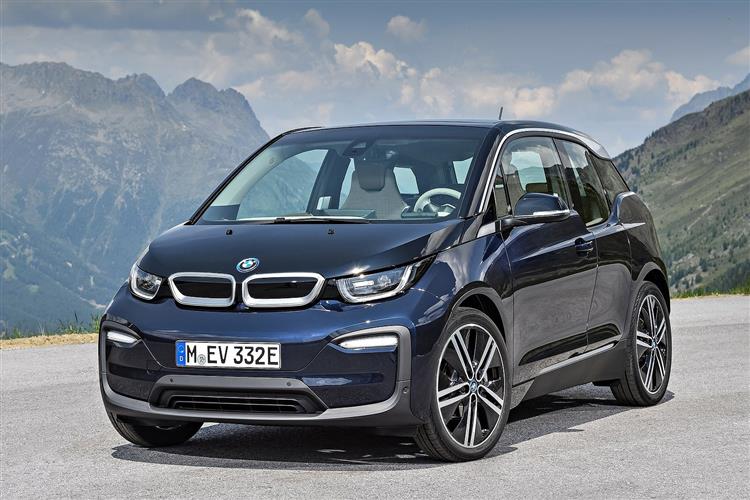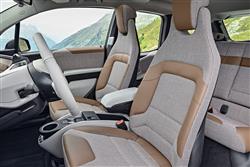THE I'S STILL HAVE IT (some text hidden) --NONE--
By Jonathan Crouch
Introductionword count: 112
If you're not yet quite convinced by the electric vehicle revolution and you want a used EV from the 2018-2022 period, then maybe this facelifted version of BMW's i3 could be the car to tempt you. This model is all the things you'd expect a compact EV from this period to be - refined, eco-conscious and super-affordable to run. But it's also surprising when it comes to sheer driving enjoyment thanks in large part to the light weight of a specially developed state-of-the-art carbon-fibre and aluminium chassis. This improved model built on that character with an extra, more focused, i3s variant. It's all part of BMW's rather different approach to EV motoring.
Modelsword count: 10
Compact 5-Door hatch - i3 full-electric / i3 Range Extender
Historyword count: 355
The i3 was originally launched back in 2013 as a first offering from its maker's 'BMW i' all-electric sub-brand into which the Munich manufacturer had ploughed over £2 billion of investment. Futuristic looks were matched with even more sophistication underneath courtesy of a ground-breaking carbon-fibre and aluminium chassis. This made the car lighter than obvious EV rivals and allowed for the installation of an optional 'Range Extender' two cylinder petrol engine for buyers needing to maximise operating range. The resulting package, in electric vehicle terms at least, turned out to be quite successful for BMW, with over 10,000 global sales by the end of 2017, helped by the fact that the brand continually developed the car following its original launch. As it needed to. The rather feeble, 60Ah/22kWh battery package supplied with the car when it was first introduced had a real world range that struggled to reach 80 miles between charges - which meant that almost three quarters of early customers felt forced to pay extra for the pricey 'REx' 'Range Extender' engine. Things improved greatly in 2016 though, when a new 94Ah/33kWh battery unit increased that range by almost 50%. As a result, in 2017 the i3 consolidated its position as our market's joint second best-selling all-electric model, vying with the Renault ZOE, both models just behind the Nissan LEAF. But of course this BMW was a pricier, more up-market-feeling product than either of those two contenders, premium credentials which were enhanced by the further round of changes that brought us this significantly improved model in 2018. It proved to be a little smarter, a little better connected and a little better equipped than the earlier version. And, most significantly, there was an additional variant, the sportier i3s, which got more power and sharper chassis dynamics. Whatever version you prefer as a used buyer, the i3 remains a car of contradictions. An individual choice, yet with mass appeal. And an eco warrior that a petrol head might also enjoy. Ultimately though, it's a BMW born to be electric - which ought to be a very good thing indeed. Production ended in late 2022.
What You Getword count: 629
Even now, the i3 still looks quite futuristic. Starting from a clean sheet of paper, the BMW eDrive development team were able to create a lightweight body perfectly balanced to suit the specific needs of its electric powerpack. The created weight saving could then be 'invested' in larger batteries to improve the operating range. That was the idea anyway: the reality saw bodywork fabricated from the kind of aluminium and carbon fibre mix you'd find on a McLaren supercar or an F1 Grand Prix racer. Those were the headlines, but the reality was that most of the carbon-fibre used was blended with plastic - which sounds far less exotic. Still, what was important was the end result. Without the batteries, what we were given here would be easily have been the lightest car on the market. We certainly like the front end, which saw a front bumper restyled for this improved model, featuring a black U-shaped surround that flows up into horizontal turn signal indicators. In the original model, this front end had introduced some subtle new vocabulary to BMW's well-established design language. The Munich maker's familiar double kidney grille is present and correct, but it's purely cosmetic as the electrically powered i3 doesn't require any cooling air, even if you do choose one with a supplementary Range Extender petrol engine fitted out back. A more controversial touch is the sudden dip in the pronounced so-called 'streamflow' shoulder line just rearwards of the front doors. It apparently was incorporated so as to create a larger side window surface for the rear passenger compartment, but at first glance, it looks like a bit of an after-thought. You'll be glad that it's there though, if you have to take a seat in the back because otherwise, that whole rear seat area would be a bit of a black hole. And pretty impossible to get to were it not for the opposing 'coach-style' doors that open to reveal the lack of the kind of central B-pillar that almost every other car in the world has to have. Back seat occupants would be pretty much trapped if this BMW had one but the bodywork and chassis of an i3 are so stiff, a centre pillar isn't necessary. So it is that, rather against the odds, what we have here is a car that's incredibly easy for anyone of any age to get in and out of. It is unfortunate though, that the rear door can't be used until the front one has been opened - which means that you'll always have to act like a chauffeur when dropping the kids off on the school run. Talk of children brings up a potentially deal-breaking point for family folk. Namely that only two people can actually be accommodated in the back, even though three would probably fit at a squash thanks to the lack of the usual centre transmission tunnel. There's a totally flat floor up-front too and the roomy feeling you get is enhanced by the low window line and the tall airy cabin. There's no conventional instrument cluster - just two high-definition LCD screens, one behind the steering wheel and the other a large central monitor standardised at 10.25-inches in size, sited at the top of the centre console and big enough for rear seat folk to see. The gear selector and start/stop button share a stalk projecting from the steering column and you engage gears using its incorporated rotary controller. The boot offers a relatively restricted 260-litre capacity thanks to its high floor. If you do need more room, the 50:50 split rear bench folds down using handles near the headrests that are easy to reach from outside the boot. Activate them and you'll create a completely flat surface freeing up 1,100-litres.
To see the full road test text contact us on 0330 0020 227
Pictures (high res disabled)

.jpg)
|
.jpg)
|
.jpg)
| |||
.jpg)
|
.jpg)
|
.jpg)
| |||

|
Scoring (subset of scores)
Category: Hybrid, Plug-in, Electric & Hydrogen
| Performance | |
| Handling | |
| Comfort | |
| Space | |
| Styling, Build, Value, Equipment, Depreciation, Handling, Insurance and Total scores are available with our full data feed. | |



